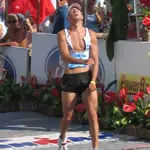I actually took the day off before this one, unlike most Tris under 1/2 Iron distance. The incentive was not just to see what I could do with a bit of rest, but to possibly net myself a top 3 finish in my age group and get a cool Tinfoilman trophy. This was the first time in as long as I can remember that I've actually coveted a trophy for its own geeky sake.
 |
| You know you want one. |
As with many triathlons, the Tucson Triathlon Series punishes those with fast swim times by starting them last. This means 3-4 hour delays between the opening of transition to set up and the actual event. Yet another reason for mass start swims. In exchange for a promise of later guarded nap time free of kid responsibilities, I took both my steed and my wife's down to outside the U of A pool and set up both our transitions. In what was probably a great stroke of luck, Karen's tire blew out completely around the valve stem as I topped it off. Better to change before the race than during. :-}
After a leisurely breakfast, we went back and waited for our swim heats, bringing our oldest as photographer, and leaving the two youngers back with grandma Sandy.
Karen's swim was 2 heats before mine, so I got to cheer her on. Then I got in and paddled away for 825 yards:
The swim felt pretty good, and I hopped out and trotted out to transition. I've been working on "flying" transitions, in my 44 year old caucasian way, so I'd set the bike up with shoes on. I put my geeky aero helmet on, stepped on a towel to dry my feet off, threw some thin, 2-layer socks on, and took off running with the bike. Transitions weren't timed, but I'm pretty sure I was in and out of T1 in roughly a minute. My head still felt a bit underwater-ish, so the running mount was more of a trotting one. Most folks pedal on top of the shoes and put their feet in one at a time, but I just slipped my feet into both shoes at once. It worked pretty well, looks notwithstanding:
 |
| Poetry (poultry?!?!) In Motion |
My power numbers on the bike weren't stellar--I held an average of 260 watts, and my 20 minute TT numbers usually run 300-325 watts. But I went pretty fast, for me: 23.5 mph average, and I didn't feel like I was burning it too hard. I felt smooth, and more importantly, I only got passed by one of my heat-mates (we were the last heat). A sprint tri, at least for me, is more of a VO2 max race than a Lactate threshold race, as an olympic tri is.
I passed Karen on one of her laps, and noted, with no small amount of pride and joy, that I thought she looked really cute even before I positively ID'ed her(!!!)
T2 was similarly blazing--I unstrapped my shoes and rode in with my feet on top of them, doing a properly executed flying dismount. I was into my shoes and running in probably 45 seconds.
It took me the first kilometer to feel like I had my legs under me, but then I got going pretty well. It helped that I got passed by some skinny punk-oid with the number "21" tattooed on his calf in sharpie (his age, for those who don't know). I let my heart rate run up from 155-ish to 159-ish, which is about as high as I can run it without making serious lactate. 5K goes pretty quickly, and it was over in no time.
Karen blazed it in 1:22:46, and was getting a head start on the bananas and gatorade at the finish line:
My line:
| 16 | Thomas Quigley | 335 | 44 | 14 | 10:39 | 15 | 32:32 | 24 | 20:35 | 1:03:46 |
I was sixteenth overall out of 305 particpants, 20:35 for the 5K, transition times included in the bike. This was 5 entire minutes faster than my race in July on the same course, which didn't seem all that slow to me at the time. I was second in my age group, netting me the coveted hardware:
The only faster 40-44 year old was a Kona Qualifier. Granted, he was 4 minutes faster than me, for a race which is roughly 1/9th of an ironman. But I'm starting to wonder if my long-term dream of qualifying is neither all that farfetched, nor all that far off. . .
Training for Ironman Coeur D'Alene begins in earnest this December. But next, meaning next week, is the Lake Mead 1/2 Ironman, which is likely to be far more representative of my long-distance potential.
Thanks to EQ for all the photos. Thanks to KQ for joining me in enjoying this pleasant torment.




 Triathlete exhausted at the Kona Finish Line.
Triathlete exhausted at the Kona Finish Line.